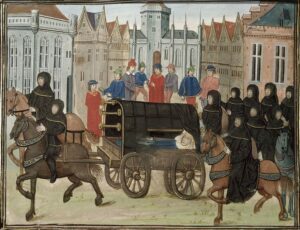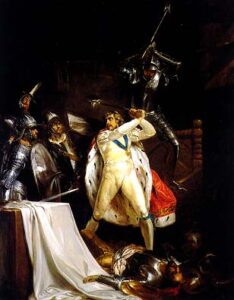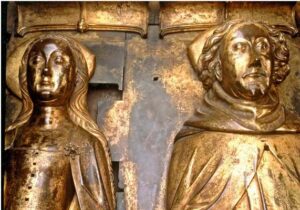Alas for Richard, this revolt sealed his fate. Or did it? In reality, no one knew what happened to the ill-fated ex-king. Rumors abounded. Finally, the first week of February, the great council attempted to resolve the question once and for all (or were they making an oblique suggestion?). They said, “that if he was still alive—as it is supposed that he is—he should be secretly guarded, but that if he were dead this should be demonstrated to the people”. Since Richard was already secretly guarded, it seems a little strange to me. All of a sudden, by February 17, it was announced that he was dead and on his way back to London. Just for the record, Richard’s death was recorded on February 14, though this seems to be a convenient date lacking any confirmation. Why? No one even knows how he died. If there were any witnesses, their lips were sealed.
There are at least four stories regarding this crucial event—and they are as far apart as you can get. The first, recounted by Shakespeare, was that King Henry sent an assassin, the otherwise unknown Sir Peter Exton with seven henchmen. The murderers burst into Richard’s cell and the king grabbed one of their weapons and put up a good fight, killing four of them before Exton smashed him in the head with an axe. Most historians disbelieve this story, especially since, upon exhumation in the 19th century, Richard’s skull was not damaged. The second story was that, hearing of the failure of the revolt and the death of his friends, Richard fell into a depression and stopped eating. At the very end, a priest convinced him that suicide was a mortal sin, and he tried to eat; but his condition was so far gone that he was unable to swallow and so expired. The third story is that Henry ordered him to be starved to death and he lingered for fifteen days in agony. Needless to say, the new king didn’t appreciate being called a regicide!
The fourth story is the most controversial of all. It was said that Richard escaped before the rebellion started and made his way to Scotland, where he was kept in honorary confinement for the next nineteen years, first by Robert III, then after the Scottish king’s death by the Duke of Albany. Needless to say, King Henry and the government scorned this assertion, but the fact remains that somebody played the part of the king in exile. Whether it was Richard himself or a pretender called Thomas Ward of Trumpington, his presence in Scotland was to harass Henry IV for the rest of his reign and into the next. According to this story, King Richard died at Stirling Castle in December 1419 and was buried at Black Friars in the same town.
In order to convince the people that Richard was truly dead, King Henry staged an elaborate procession where the body—encased in lead except for his face from the eyebrows to the throat—was set on a bier and drawn on a carriage from Pontefract to London, exposed for all the populace to see. A solemn funeral was held for two days at St. Paul’s Cathedral which was attended by the king. Afterwards, the corpse was taken to the royal manor of Chiltern Langley and handed over the Black Friars, who privately buried him in the church; the only witnesses were the Bishop of Lichfield and the Abbots of Waltham and St. Albans. Richard’s tomb at Westminster Abbey was finished and waiting for his royal body, but the usurper didn’t want to draw attention to such a royal setting for a deposed king.
So if Richard was still alive, whose face was on the funeral bier? Why, Maudeleyn, of course, his look-alike cleric who had been decapitated after the rebellion. From a distance, who would have been able to tell the difference?
Almost immediately, reports of Richard’s escape proliferated throughout England. Repercussions were quick to follow. In 1402, a priest from Ware was drawn and quartered for spreading such rumors. Not long afterwards, eight Franciscan friars were hanged in London for asserting that Richard was still alive. But the most damaging to Henry came in 1403, when Sir Henry Percy, aka Hotspur, raised a rebellion predominately from Chester, swearing that King Richard was returning from Scotland to lead his army. At the last minute he admitted that Richard was dead, but apparently he was able to rely on the soldiers’ fondness for the late king—or maybe he used coercion—because they went on to fight a horrific battle at Shrewsbury that nearly toppled Henry from his throne. The potential for Richard’s return continued to inspire disgruntled rebels, though eventually, the cry was that they fought for Richard if he was still alive, or else the Earl of March if he was dead. (March was the heir presumptive and kept in Henry’s custody for years.)
When Henry IV died in 1413, the first thing his successor did was transfer Richard at great expense from Langley to his real tomb at Westminster Abbey, thus symbolically putting Richard to rest and establishing Henry V as the rightful successor to the throne. Rumors were to follow him for the next couple of years, but by then they had lost most of their influence. The last time Richard was invoked was during the Southampton Plot in 1415, and it was March himself who exposed the conspiracy.



No comments:
Post a Comment